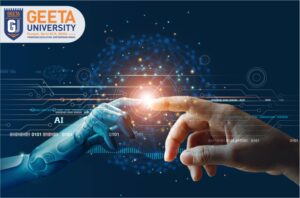Python: The Versatile and Innovative Language
UncategorizedPython: The Versatile and Innovative Language
- July 1, 2024
- Geeta University
Overview
Python is a high-level, interpreted programming language whose ease of use and versatility have completely changed the software development industry. Python was created by Guido van Rossum in 1991, and since then, developers, data scientists, educators, and enthusiasts have come to love it. From web development to artificial intelligence, its large libraries, readability, and straightforward syntax make it perfect for a wide range of applications. This blog discusses Python’s features, applications, history, and upcoming trends to show why it’s still the language of choice for developers all over the world.
A Synopsis of Python’s Past
The history of Python began in the late 1980s when Guido van Rossum at Centrum Wiskunde & Informatica (CWI) in the Netherlands started working on a new project. Python was created with an emphasis on readability and simplicity of code, drawing inspiration from ABC.
When Python 1.0 was launched in January 1994, it included fundamental functionality including functions, exception handling, and core data types (strings, dictionaries, and lists). With the introduction of Python 2.0 in October 2000, the language saw a rapid evolution that included the establishment of the Python Software Foundation (PSF), garbage collection, and list comprehensions.
Python 3.0 was released in December 2008 to fix serious architectural errors. The Python 3.x series did away with superfluous constructs and enhanced language consistency, however it was incompatible with Python 2.x. After developers migrated their codebases to Python 3, the language’s future was cemented when Python 2 was formally terminated in January 2020.
Essential Elements of Python
Python is widely used because of its extensive feature set, which accommodates both novice and expert developers. The following are some of its salient characteristics: • Readability and Simplicity: Python’s succinct syntax is similar to plain English, which facilitates learning and writing code. Its readable nature facilitates improved teamwork and lowers the learning curve for novice developers.
Python is an interpreted language, which means that commands are carried out line by line. This makes testing and debugging easier and enables prompt error detection and correction.
• Dynamically Typed: Python enables quicker development by eliminating the need for explicit variable type declarations. However, to prevent runtime mistakes, careful control is required.
• Comprehensive Standard Library: Python’s standard library reduces the need for external dependencies by offering modules and packages for a variety of activities like file I/O, system calls, web development, and data manipulation.
• Cross-Platform Compatibility: Because Python is compatible with a wide range of operating systems, including Windows, macOS, Linux, and Unix, programs may be designed and implemented with little to no alteration across different platforms.
• Support and Community: A sizable and vibrant community exists for Python, actively contributing to its upkeep and advancement. Developers may discover answers and support more easily with the help of third-party libraries, extensive documentation, and tutorials.
Applications of Python
Python’s adaptability makes it useful across a wide range of industries. Leading application domains include of:
1. Website creation:
o Django: A high-level framework with an admin interface, an ORM system, and copious documentation that encourages quick development and tidy design.
o Flask: A tiny framework that is easy to use and flexible, perfect for small to medium-sized projects.
o Pyramid: A scalable framework appropriate for big, complicated systems as well as simple applications.
2. Machine Learning and Data Science:
o NumPy: Provides support for sizable matrices and multidimensional arrays with mathematical functions.
Pandas: Makes data manipulation, cleaning, and analysis easier by offering data structures and analysis tools for structured data.
o Matplotlib: An interactive, animated, and static visualization toolkit for plotting.
o SciPy: Expands upon NumPy to provide statistical, integration, and optimization tools for scientific computing.
o scikit-learn: A machine learning library containing dimensionality reduction, clustering, regression, and classification methods.
o Deep learning frameworks for creating neural networks and other machine learning models include TensorFlow and PyTorch.
Overview
PyTorch has become a top framework in the quickly developing fields of deep learning and artificial intelligence, enabling researchers and developers to build state-of-the-art machine learning models. PyTorch is an open-source deep learning library that was created by Facebook’s AI Research lab (FAIR) and released in 2016. It has been incredibly popular due to its versatility, user-friendliness, and robust support for dynamic computation graphs. This blog will examine PyTorch’s salient characteristics, benefits, and uses, emphasizing the reasons the AI community now prefers it.
Important Properties of PyTorch: 1. Graphs for Dynamic Computation
Support for define-by-run, or dynamic computation graphs, is one of PyTorch’s most notable features. Dynamic computation graphs, as contrast to static ones, are produced dynamically during runtime. Because of this flexibility, developers can make changes to and examine the graph while the model is running, which facilitates more intuitive model creation and simpler troubleshooting. Because of its ability to handle complex models and variable-length inputs, PyTorch is a popular choice among researchers engaged in innovative architecture experiments.
2. Natural Pythonism
PyTorch is intended to be tightly linked with Python, taking advantage of its built-in grammar and data structures. Because of this, writing and reading PyTorch code is simple, and it integrates well with other Python tools and modules. Developers may rapidly experiment and iterate on their models because to the user-friendly API design, greatly speeding up the development process.
3. All-encompassing Ecosystem
PyTorch has an extensive ecosystem with strong libraries for several types of deep learning jobs. Torchaudio offers tools and datasets for audio processing, Torchtext for natural language processing, and Torchvision for computer vision. A variety of scientific computing applications are made possible by PyTorch’s enhanced capabilities due to its interaction with libraries such as NumPy and SciPy.
4. A robust community and assistance
The thriving community of PyTorch is essential to its success. New users can quickly become up to speed with the help of a growing collection of pre-trained models, tutorials, and substantial documentation. The vibrant community also helps to shape and refine the framework, keeping it state-of-the-art and dependable.
One of PyTorch’s benefits is its flexibility and control.
Unmatched flexibility and control over the model-building and training operations are made possible by PyTorch’s dynamic nature. It is simple for researchers to experiment with various architectures, apply sophisticated models, and customize training loops to meet their unique requirements. This flexibility is essential for advancing AI research.
2. Python Integration That Is Smooth
Developers may take advantage of the robust Python environment thanks to PyTorch’s smooth integration with Python. PyTorch integrates seamlessly with well-known libraries, improving productivity and optimizing the development process for tasks like data manipulation with pandas and visualization with Matplotlib.
3. Effective Calculation
PyTorch is designed to run as efficiently as possible, using little memory and supporting GPU hardware acceleration. This allows for quicker training and inference, making it appropriate for large-scale deep learning problems. Distributed computing is also supported by the library, enabling models to scale across numerous GPUs and nodes.
PyTorch applications
1. Academic Research Because of its adaptability and simplicity in conducting experiments, PyTorch is widely employed in academic research. PyTorch has been used to create many innovative research articles and models, such as those in computer vision, reinforcement learning, and natural language processing. It is perfect for experimenting and iterating on new ideas because of its dynamic graph capabilities and user-friendly design.
2. Adoption by Industry
PyTorch has been widely used in industry in addition to academia. Prominent technology corporations such as Facebook, Microsoft, and Tesla employ PyTorch for a range of uses, encompassing recommendation systems and autonomous driving. It is appropriate for practical AI applications due to its strong production capabilities and simplicity of deployment.
3. Education Due to its ease of use and readability, Python is also well-liked in educational settings, where it is a great instrument for imparting profound learning principles. PyTorch has become the framework of choice for numerous online tutorials, courses, and university programs, assisting students in laying a strong foundation in AI and machine learning.
3. Scripting and Automation: o Selenium: This program automates web browsers and is frequently used for web scraping and app testing.
o Ansible: An open-source automation tool with straightforward, human-readable syntax for task automation, application deployment, and configuration management.
4. Software Development: o PyQt: Python bindings for the Qt application framework, allowing cross-platform graphics and user interfaces to appear native.
o Kivy: A free and open-source framework for creating multi-touch desktop and mobile applications.
o Tkinter: The default Python GUI library that makes it easy to construct graphical user interfaces for desktop programs.
5. Networking and Cybersecurity: o Paramiko: Manages SSH connections to enable safe remote file transfers and command execution.
o Twisted: An event-driven networking engine that is compatible with SSH, SMTP, and HTTP.
o Spy: A tool for manipulating packets used in network penetration testing, packet creation, and network discovery.
The Environment of Python
Driven by a strong community and ongoing development, the Python environment is large and ever-changing. Important elements consist of:
1. Python Package Index (PyPI): Thousands of third-party libraries that increase the capability of Python are housed in this official repository for packages. With pip, developers can install and manage these programs with ease.
2. Integrated Development Environments (IDEs): o PyCharm: A potent JetBrains IDE for Python development that includes a built-in debugger, refactoring tools, and intelligent code completion.
o Visual Studio Code: An open-source, lightweight editor from Microsoft with strong support for Python via extensions. It has an integrated terminal, syntax highlighting, and IntelliSense.
o Jupyter Notebook: An open-source online interactive computing tool for creating and sharing documents with real-time code, equations, graphics, and narrative text that is extensively used in data science and research.
3. Version Control: To manage their codebases, Python developers utilize version control systems such as Git. It is simpler to track changes and collaborate with teams when using platforms like GitHub, GitLab, and Bitbucket, which provide collaboration, code review, and project management.
4. Continuous Integration/Deployment (CI/CD): CI/CD techniques are essential to contemporary software development because they guarantee that code modifications are automatically deployed and tested. Python projects are supported by tools like Travis CI, CircleCI, and Jenkins, which make automated building, testing, and deployment procedures possible.
Python in the Classroom
Python is a great language for teaching because of its readability and simplicity. Python is widely used in education to teach data structures, algorithms, and programming basics in schools, colleges, and universities. Python’s wide range of applications enables students to study a variety of subjects using just one language, from web programming to data science.
Prospective Patterns and Advancements
Python has a bright future ahead of it thanks to continual advancements and new trends that will increase its functionality and range of uses.
1. Python 4.0: The Python community expects future versions to bring new features, enhance performance, and preserve backward compatibility, even if there is no official release date for Python 4.0. Improved standard libraries, improved memory management, and quicker execution are among the focus areas.
2. Growing Adoption in Emerging Technologies: Python is predicted to play a bigger part in cutting-edge research and development in emerging technologies including artificial intelligence, machine learning, and quantum computing as a result of developing libraries and frameworks.
3. Improved Performance: Python’s performance is being worked on. Accelerating execution speed is the goal of projects like PyPy, an alternate Python implementation with a Just-In-Time (JIT) compiler. Initiatives like Cython, which translates Python code into C, also improve efficiency for tasks requiring a lot of processing.
4. Integration with Other Languages: Python is expected to become more compatible with other languages, including C, C++, and Java, allowing programmers to take use of Python’s ease of use while still getting the speed and specialized capabilities of other languages.
In summary
Python has come a long way from being a basic scripting language to a powerful and adaptable tool. Its widespread popularity across multiple domains has been fueled by its extensive library, lively community, and ease of reading. Python is a great option for solving a variety of programming challenges since it offers a large environment and a promising future, regardless of experience level. Python will surely stay at the vanguard of technological advancements, enabling developers to innovate and produce solutions that change the world.

Admission Open 2024-2025
For Your bright Future
Tags
Related Posts

What is Data Security? | Why is Data Security important? | Types of Data Protection – Geeta University
For a variety of reasons, data security is critical for both public and commercial enterprises. First, there is the legal and ethical obligation of companies to protect their user and customer data from falling into the wrong hands. What is

Artificial Intelligence: AI Terms Simply Explained – Geeta University
Unlike humans, AI learns and excels at a limited number of tasks. Weak or thin AI is the name given to such associate AI. They are currently typically superior to humans in their field. Artificial intelligence: AI Terms Simply Explained

Career in Mechanical Engineering – Scope, Courses – Geeta University
Career in Mechanical Engineering- Are you dreaming of making a career in Mechanical Engineering? Do you want this information that how to become Mechanical Engineer. Career in Mechanical Engineering – Scope, Courses Scope of Mechanical Engineering Career in Mechanical Engineering-
